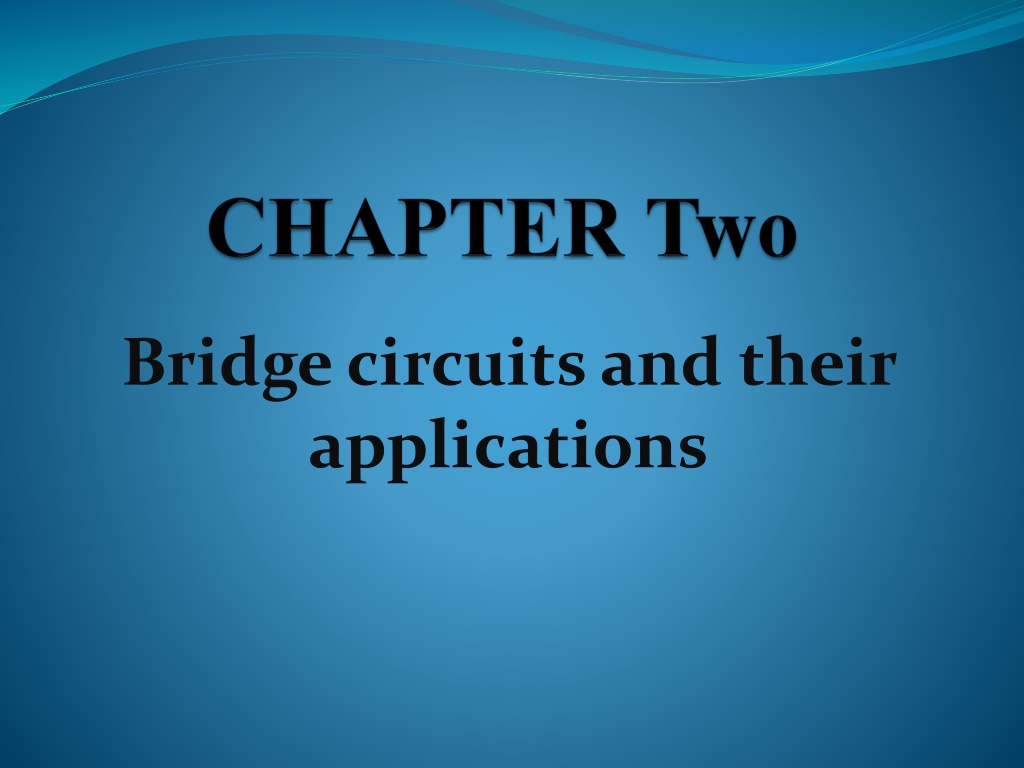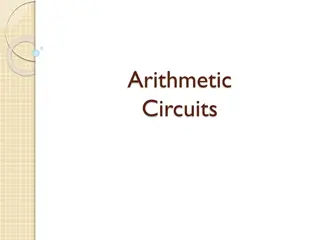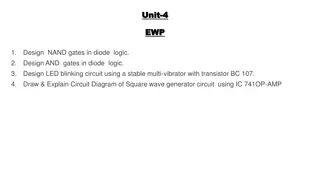Bridge circuits and their applications
Bridge circuits are commonly used for precision measurement of component values such as resistance, inductance, and capacitance. The Wheatstone bridge, a type of bridge circuit, is particularly useful for measuring small changes in resistance, making it ideal for sensor applications. By comparing unknown resistance with known values, the Wheatstone bridge provides accurate results through a balanced condition. Additionally, unbalanced Wheatstone bridges are utilized to measure transducer quantities like strain, temperature, and pressure by detecting deviations in output voltage from a known balanced point.
Download Presentation

Please find below an Image/Link to download the presentation.
The content on the website is provided AS IS for your information and personal use only. It may not be sold, licensed, or shared on other websites without obtaining consent from the author. Download presentation by click this link. If you encounter any issues during the download, it is possible that the publisher has removed the file from their server.
E N D
Presentation Transcript
Bridge circuits and their applications
Introduction Bridges are often used for the precision measurement of component values, like resistance, inductance, capacitance, etc. The simplest form of a bridge circuit consists of a network of four resistance arms forming a closed circuit as shown in .Fig. 4.1
D.C. Wheatstone bridge The most common and simplest bridge network to find the resistance is the DC Wheatstone Bridge. This bridge is used where small changes in resistance are to be measured like in sensor applications. This is used to convert a resistance change to a voltage change of a transducer.
D.C. Wheatstone bridge A Wheatstone bridge consists of four resistors that are connected in the shape of a diamond with the supply source and indicating instruments as shown in figure This bridge is used to find the unknown resistance precisely by comparing it with a known value of resistances. In this bridge null or balanced condition is used to find the resistance very
D.C. Wheatstone bridge For this bridge balanced condition voltage at points C and D must be equal. Hence, no current flows through the galvanometer. For getting the balanced condition one of the resistors must be variable ? ?? ?3+?? The voltage at point D ??= ? ?2 ?1+?2 The voltage at point C ??=
The voltage (V) across galvanometer or between C and D is: ? ?2 ?1+?2 ? ?? ?3+?? ???= ?? ?? When the bridge is balanced VCD= 0 ? ?? ?3+?? ? ?? ?3+??= ? ?2 ?1+?2= 0 Unbalanced Wheatstone Bridge ? ?2 ?1+?2 ???1+ ?2 = ?2(?3+ ??) ??=?2?3 ?1
Unbalanced Wheatstone Bridge The unbalanced bridge is used to measure some transducer quantities, such as strain, temperature, or pressure. The bridge is balanced at a known point, then the amount of deviation, as indicated by the output voltage, indicates the amount of change in the parameter being measured.
The value of the parameter being measured can be determined by the amount that the bridge is unbalanced. Tiny changes in transducer resistance will unbalance the bridge, thereby providing a measurement reading
Example:- Consider using a Wheatstone bridge having R1 = 200 and R2 = 2000 to measure a resistance Rm . The bridge is balanced by adjusting R3 until R3 = 250 . What is the value of Rm ? Solution:
Example:- Consider using a Wheatstone bridge having R1 = 200 and R2 = 2000 to measure a resistance, Rm , of a temperature sensor. Suppose the resistance of the temperature sensor, Rm , in , is related to the temperature T, in C, by the equation Rm =1500 + 25T The bridge is balanced by adjusting R3 until R3 = 250 . What is the value of the temperature?
HW Consider using a Wheatstone bridge having R1 = 200 and R2 = 2000 to measure a resistance, Rm , of a temperature sensor. Suppose the resistance of the temperature sensor, Rm , in , is related to the temperature T, in C, by the equation Rm =1500 + 25T The temperature is expected to vary over the range 0 to 100 C. Over what range must R3 vary in order for the bridge to measure temperature over the range 0 to 100 C?
HW For the Wheatstone bridge circuit of Fig., solve the following problems: (a) If R1 = 1 , R2 = 2 , and Rx = 3 , to what value should R3 be adjusted so as to achieve a balanced condition? (b) (b) If V0 = 6 V, Ra = 0.1 , and Rx were then to deviate by a small amount to Rx = 3.01 , what would be the reading on the ammeter ?
AC Bridge Circuits AC bridge circuits work on the same basic principle as DC bridge circuits: that a balanced ratio of impedances (rather than resistances) will result in a "balanced" condition as indicated by the null-detector device. Null detectors for AC bridges may be sensitive electromechanical meter movements, oscilloscopes (CRT's), headphones (amplified or unamplified), or any other device capable of registering very small AC voltage levels.
A.C . Wheatstone bridge An AC Wheatstone Bridge is similar to a DC Wheatstone Bridge except for: Common AC Source. Resistances R may be replaced by impedances Z. When measuring impedances, an AC Wheatstone Bridge is often referred to as a general impedance bridge.























